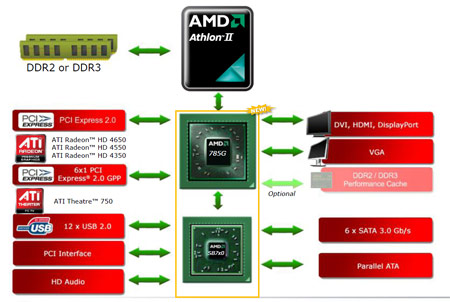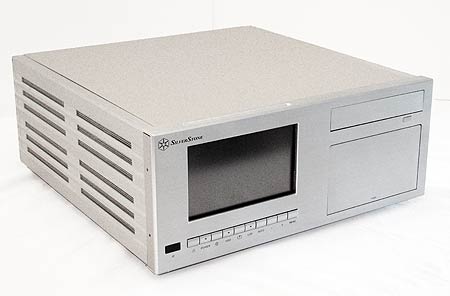Updated: AMD 785G: The Venerable 780G, Evolved
Conclusion

Here's the bottom line: the 785G is a welcome update to a highly-regarded IGP, but with no more raw power than the 780G it will replace. The 785G is essentially the 780G chipset re-introduced with a number of attractive features, and it looks even better beside AMD's value-oriented Phenom II and Athlon II processors.
Is the 785G the best IGP out there? The answer is going to depend on what the PC will be used for and whether the apps you want to run work better with a Phenom II or Core 2 processor. With this in mind, let's examine a few of the primary reasons someone would want an integrated chipset, and specific recommendations for those applications.
Home Theater PC:

Which IGP is the best in a home theater PC? At this point I would have to say Nvidia's GeForce 9300/9400 and the 785G are running a close race, with the G45 slightly behind both due to a lack of picture-in-picture acceleration and a lower video playback quality (we'll explore this HTPC Blu-ray playback on these IGPs in a dedicated article in the very near future). Despite the update that 785G does not, in fact, feature eight-channel LPCM audio output, this remains a feature limited to a certain class of HTPC enthusiasts who run more complex speaker setups.
If money is a factor and eight-channel LPCM isn't necessary, then the 780G is the way to go at prices far below the GeForce 9300/9400.
Low-Cost Gaming PC:
For this specific use, I'd recommend skipping IGPs altogether and opting for a non-IGP motherboard of your choice in addition to a discrete graphics card. The Radeon HD 4350 is far more powerful than all of these IGPs, and can be found for under $35 online, while $50 gets you into Radeon HD 4650 territory and true 1280x1024 gaming. If you really don't have the $35 to spend, I'd recommend the 780G with a solid overclock to the graphics chipset. If you can't afford a discrete card today but plan on multiple cards in the future, the 790GX is the way to go with its dual-card CrossFireX capability.
Stay On the Cutting Edge: Get the Tom's Hardware Newsletter
Get Tom's Hardware's best news and in-depth reviews, straight to your inbox.
All-Purpose PC
As a general, all-purpose PC for the home, I'd recommend the 780G or 785G, and not because of the chipset so much as the low cost of solid CPUs that drop into them. The Phenom II X2 and Phenom II X3 really do offer a great deal of performance for the price right now.
While Intel does offer its own low-priced Core 2 and Pentium dual-core gems, the G45 trades off too much in the graphics power department to be attractive, and the GeForce 9300/9400 motherboards are inexplicably expensive. The cheapest 780G motherboard is $45 less than the cheapest 9300 motherboard we can find, which is almost the cost of a discrete Radeon HD 4650.
In the final analysis, the 785G is a fine addition to AMD's chipset portfolio, and is perhaps most compelling for home-theater enthusiasts.
-
macer1 the real question is how would this perform if mated to an Atom processor in an nettop.Reply -
mcnuggetofdeath "refined architecture" ? To my knowledge, and please correct me if im wrong, all that was changed between the original phenom and the phenom 2 was the addition of more L3 cache allowing it to do more simultaneously and a die shrink allowing for higher clocks. That does not a refined architecture make. When AMD added an on die memory controller to their processors years ago they had made a huge advancement in architecture. Im sad to see them fall away from the performance crown. Here's hoping their new Bull Dozer architecture brings something genuinely intriguing to the table.Reply -
anamaniac Very interesting.Reply
A integrated GPU that can game. =D
Makes my lil Pentium D with a 4670 seem puny...
3.3GB/s memory bandwidth (single channel DDR2 533... though 2 sticks, it runs in single channel... damn prebuilts) also seems sad on my rig...
macer1the real question is how would this perform if mated to an Atom processor in an nettop.
Good question. A dual core Atom with a 4200 integrated would be nice.
We all know Intel makes shitty mothebroards and AMD makes kickass motherboards anyways. -
SpadeM mcnuggetofdeath^^^ and support for DDR3. Although thats a change to the board, not the CPU.Reply
Not correct, the P2 has a built in memory controller so the switch to ddr3 affected that controller -
apache_lives anamaniacVery interesting.A integrated GPU that can game. =DMakes my lil Pentium D with a 4670 seem puny...3.3GB/s memory bandwidth (single channel DDR2 533... though 2 sticks, it runs in single channel... damn prebuilts) also seems sad on my rig...Good question. A dual core Atom with a 4200 integrated would be nice.We all know Intel makes shitty mothebroards and AMD makes kickass motherboards anyways.Reply
Native ram for a pentium d is PC4200 which has a max of 4.2gb/s per channel etc and the FSB has the max of 6.4gb/s
The Intel atom would most likely underpower any video card out there, and Intel does actually make a good reliable business platform where video performance is not required etc -
I'm sorry, is this an Intel benchmark site? All other reviews put SYSTEM power consumption for Athlon II 250 well below Intel E7200.Reply
-
aproldcuk This article raised a lot of questions for me. What about Hybrid Crossfire for example? What kind of cards can be used together with this new IGP? Is the discrete graphics card on standby if no performance is required? If no then how much extra outlet wattage is expected? And how much extra if actively in use? I'm interested in using the 785G solution in the 24/7 HTPC setup with the possibility to do occasional gaming as well. My current setup with 690G chipset and Athlon 64 X2 BE-2350 CPU draws around 50 watts most of the time and up to 90 watts under heavy load. Is it too much to expect similar levels from 785G and Phenom II X3 705e combo for example?Reply -
wh3resmycar when can we see the mobile version of this? this is most certainly a welcome update compared to the 780g-hd3200 chipset. and beats any nvidia igp hands down. id love to see this on an $700-$800 laptop. good thing im still holding back on buying a new notebook.Reply